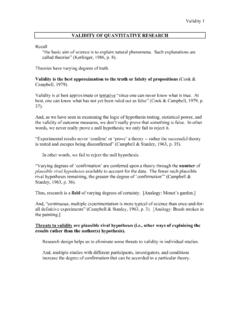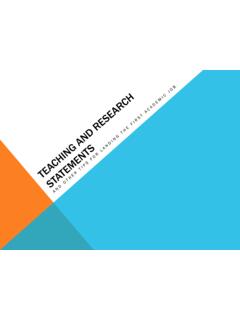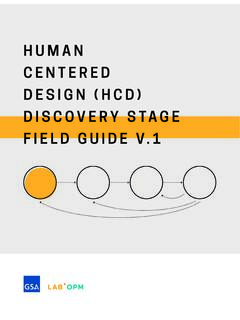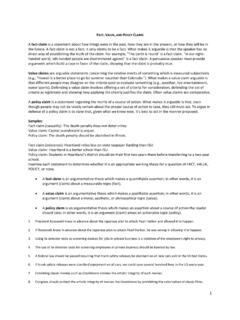Transcription of PROGRAM ASSESSMENT HANDBOOK - University of Central …
1 PROGRAM ASSESSMENT HANDBOOK . GUIDELINES FOR PLANNING AND IMPLEMENTING. QUALITY. ENHANCING. EFFORTS. OF PROGRAM AND STUDENT LEARNING OUTCOMES. February 2008 edition Contact: 2005 University of Central Florida PROGRAM ASSESSMENT HANDBOOK . GUIDELINES FOR PLANNING AND IMPLEMENTING. QUALITY. ENHANCING. EFFORTS. OF PROGRAM AND STUDENT LEARNING OUTCOMES. The purpose of this HANDBOOK is to provide academic programs with a framework for developing an ASSESSMENT plan with the objective of improving an academic PROGRAM . In Chapter 1, an overview of ASSESSMENT and more specifically PROGRAM ASSESSMENT is introduced.
2 Guidelines and suggestions for planning for PROGRAM ASSESSMENT are provided in Chapter 2. Methods that can be used to assist the department in developing its mission and PROGRAM goals statements are included in Chapter 3. Chapter 4 is describes the development of student learning outcomes and includes a checklist and a preparation form to aid those involved in the ASSESSMENT process. An inventory of PROGRAM ASSESSMENT tools, methods and techniques is outlined in Chapter 5. Chapter 6. provides an overview of documenting and using data from ASSESSMENT .
3 We would like to acknowledge the work of colleagues at other institutions (referenced throughout the HANDBOOK ). MOST COMMON MISCONCEPTIONS ABOUT. PROGRAM ASSESSMENT . Misconception 1: The results of ASSESSMENT will be used to evaluate faculty performance. Nothing could be further from the truth . Faculty awareness, participation, and ownership are essential for successful PROGRAM ASSESSMENT , but ASSESSMENT results should never be used to evaluate or judge individual faculty performance. The results of PROGRAM ASSESSMENT are used to improve programs.
4 Misconception 2: Our PROGRAM is working well, our students are learning; we don't need to bother with ASSESSMENT . The primary purpose of PROGRAM ASSESSMENT is to improve the quality of educational programs by improving student learning. Even if you feel that the quality of your PROGRAM is good, there is always room for improvement. In addition, various accrediting bodies mandate conducting student outcomes ASSESSMENT . For example, the Southern Association of Colleges and Schools (SACS) requires that every PROGRAM assess its student outcomes and uses the results to improve programs.
5 Not to conduct ASSESSMENT is not an option. Misconception 3: We will assign a single faculty member to conduct the ASSESSMENT . Too many opinions would only delay and hinder the process. While it is a good idea to have one or two faculty members head the ASSESSMENT process for the department, it is really important and beneficial to have all faculty members involved. Each person brings to the table different perspectives and ideas for improving the academic PROGRAM . Also it is important that all faculty members understand and agree to the mission ( , purpose) and goals of the academic PROGRAM .
6 Misconception 4: The administration might use the results to eliminate some of the department's programs. There are two types of evaluation processes: summative and formative. The purpose of summative PROGRAM evaluation is to judge the quality and worth of a PROGRAM . On the other hand, the purpose of formative PROGRAM evaluation is to provide feedback to help improve and modify a PROGRAM . PROGRAM ASSESSMENT is intended as a formative evaluation and not a summative evaluation. The results of PROGRAM ASSESSMENT will not be used to eliminate programs.
7 Misconception 5: ASSESSMENT is a waste of time and does not benefit the students. The primary purpose of ASSESSMENT is to identify the important objectives and learning outcomes for your PROGRAM with the purpose of improving student learning. Anything that enhances and improves the learning, knowledge and growth of your students cannot be considered a waste of time. 2005 University of Central Florida i UCF Academic PROGRAM ASSESSMENT HANDBOOK February 2008. Operational Excellence and ASSESSMENT Support Misconception 6: We will come up with an ASSESSMENT plan for this year and use it every year thereafter.
8 For PROGRAM ASSESSMENT to be successful, it must be an ongoing and continuous process. Just as your PROGRAM should be improving, so should your ASSESSMENT plan and measurement methods. Each academic department must look at its programs and its learning outcomes on a continual basis and determine if there are better ways to measure student learning and other PROGRAM outcomes. Your ASSESSMENT plan should be continuously reviewed and improved. Misconception 7: PROGRAM ASSESSMENT sounds like a good idea, but it is time- consuming and complex.
9 It is impossible to get something for nothing. Effective PROGRAM ASSESSMENT will take some of your time and effort, but there are steps that you can follow that can help you to develop an ASSESSMENT plan that will lead to improving student learning. Also, the office of Operational Excellence and ASSESSMENT Support (OEAS) is available to provide you with assistance. If you need any help go to , the Operational Excellence and ASSESSMENT Support website for guidelines and assistance in conducting PROGRAM ASSESSMENT or contact the office (407-882-0277) to make an appointment for a consultation.
10 2005 University of Central Florida ii UCF Academic PROGRAM ASSESSMENT HANDBOOK February 2008. Operational Excellence and ASSESSMENT Support HANDBOOK CONTENTS. What is ASSESSMENT and why should you assess? Chapter 1 provides an overview of the ASSESSMENT process at UCF and defines the concept of PROGRAM ASSESSMENT . Also, this chapter introduces the purposes and characteristics of ASSESSMENT to help you when you are thinking about how ASSESSMENT can benefit your PROGRAM . How should you plan for PROGRAM ASSESSMENT ?






